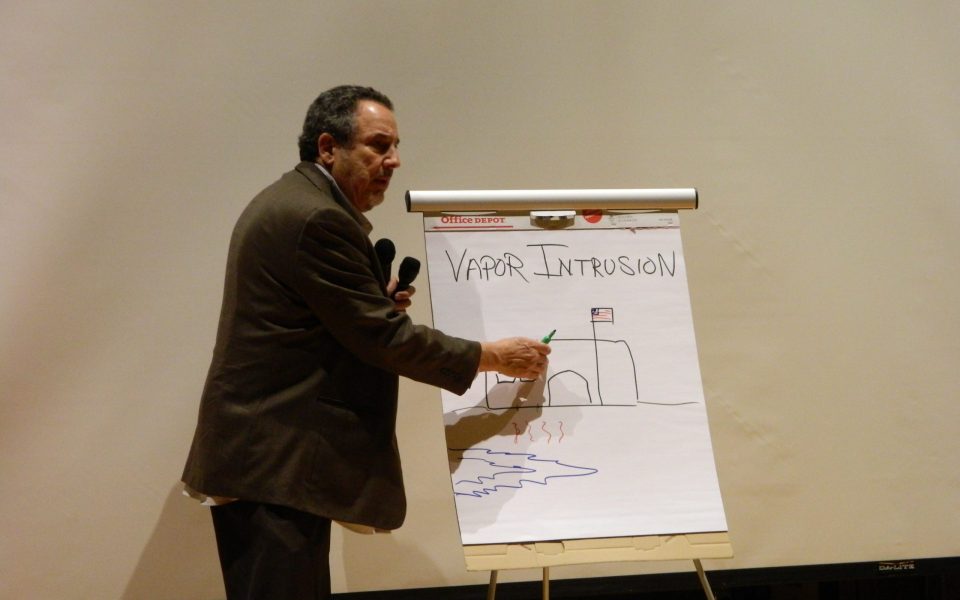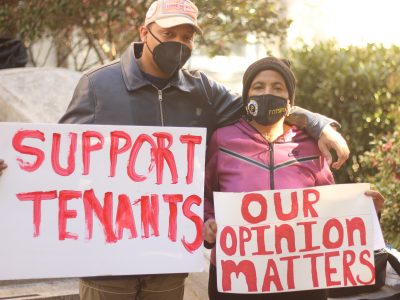by Jordan Green
Experts tell parents and school officials they need more data to determine whether Hanes and Lowrance middle schools are safe, but regardless they should take pre-emptive mitigation measures soon.
Lenny Siegel, a nationally renowned expert on vapor intrusion who has represented communities affected by contamination across the country, stood before members of the Winston-Salem/Forsyth County School Board during a briefing in the Auditorium of Atkins High School on Monday.
Siegel told the board he understood why the parents of students and Hanes and Lowrance middle schools were upset when they learned that the ground beneath the schools was contaminated by tetrachloroethylene, or PCE, a chemical that can cause damage to the liver, kidneys and the central nervous system.
“The risk to PCE, the principal contaminant at the site, and the standards are based on 30 years exposure, 24-7,” Siegel said. “Based on the science, I don’t think there’s a reason to panic. There’s a need to address the problem, but I don’t think there’s a need necessarily to pull kids out of school or close the school right away.”
Along with Kelly Pennell, an assistant professor of civil engineering at the University of Kentucky Superfund Research Program, and Kathleen Gray, the research translation core leader at the UNC Superfund Research Program, Siegel came to Winston-Salem at the invitation of a Traci Connor, a parent at Hanes Middle School.
Now with the Children’s Museum of Winston-Salem, Connor drew upon connections she made as director of exhibit development at the Museum of Life and Science in Durham to track down experts in toxicology and vapor intrusion, eventually leading to the UNC Superfund Research Program. Gray said the 19 Superfund Research Programs across the United States all have a mandate from their funders to provide outreach assistance to communities dealing with contamination.
Meanwhile, the district has hired Mid-Atlantic Associates, an environmental and engineering consulting firm, to conduct an intensive round of air-quality tests at the schools over the weekend. Will Service with Mid-Atlantic told the board that the firm will take air samples from 31 locations, including inside the buildings, outside and from the ground. The cold weather anticipated this weekend is expected to provide results for the worst-case scenario, considering that buildings tend to be more tightly sealed in the winter.
Service said he expects to have test results by the end of the month.
Siegel recommended that the district consider “pre-emptive mitigation” after receiving the first round of test results because continuous monitoring can be expensive, and results will never be completely conclusive. He told the school board that one mitigation measure might be depressurizing the ground beneath the schools to make vapors flow downward. Another might be to relocate the schools altogether.
The school board discussed options for temporarily moving students to other schools, including Winston-Salem Preparatory Academy. Superintendent Beverly Emory said school officials met with principals on Feb. 6 to discuss their options. Emory said after the meeting that Winston-Salem Prep has a capacity of 800-1,000 students, but its actual enrollment is only 400. Some of the excess space is being used for other functions, including the district’s newcomers program.
Pennell, the University of Kentucky researcher, said that vapor intrusion research is an emerging science, with research beginning in 2005. Unanswered questions include how weather affects vapor migration and how uneven pressure inside buildings is affected by subsoil temperature.
Siegel told about 40 parents at a separate presentation at SciWorks later in the evening that the extensive testing undertaken by the district is what should have been done all along. He said the new round of testing is likely to address questions about whether elevated levels of PCE previously detected at the school site resulted from the underground toxic plume or materials inside the school such as carpet adhesive. Sampling air in classrooms where potential indoor sources of contamination have been removed is one way to pinpoint the source.
“If you’re serious in trying to protect people, that’s what you need to do,” Siegel said. “Belatedly, I think that’s what’s finally happening here, but at a cost of the community losing trust in the entity that was responsible for protecting them. What I’m hoping is that you can set aside the injury that you suffered by not being informed and still try to make informed decisions about what you think needs to be done.”
Emphasizing the need for comprehensive data, Siegel and Pennell both said the district needs “multiple lines of evidence” to determine whether the contaminated plume underground is causing unsafe levels of chemical exposure in the schools.
Siegel said if further testing uncovers elevated levels of trichloroethylene, or TCE, a known carcinogen, that would be a cause for greater concern.
“If indeed they find that TCE is coming up from the subsurface into the building and female teachers who might get pregnant are exposed, an action has to be taken almost immediately,” he said. “So TCE is different from PCE right now because of the risks of cardiac birth defects.”
When he looked at data from two previous air samples taken at Hanes and Lowrance middle schools, Siegel said he found one sample of 17 micrograms per cubic liter, or 17µg/m3 and another at 4.5µg/m3, both exceeding the acceptable level of 2µg/m3.
“I said, ‘Uh oh, that’s a problem,’” Siegel said. “Well, right now evidence is that they tested the soil for TCE and they didn’t find it, and indeed they found some chemicals in one of those buildings.”
Siegel added that parents and other members of the school community need more data to confirm that the contaminants are coming from the ground as opposed to indoor chemicals.
“The key thing I tell the responsible parties — the EPA, the polluters, the regulators, DENR: ‘It’s your responsibility to do your best to inform the public,’” Siegel said. “‘And if you think the public is going to react irrationally, you’ll find that they’ll react most irrationally if you don’t tell them truth.’ I think the school district has learned their lesson. I’m not sure who was responsible for not letting the public know what was going on there. But I see this time and time again across the country — that government officials don’t want to panic people so they don’t tell them anything. But when people hear important information about their health, their property and their kids’ health, they are going to be suspicious of anything they hear.”
Parents pressed Siegel and Pennell to tell them how to interpret the data when the sample results come back later this month. Pennell indicated she favors the US standard of 8µg/m3, while Siegel said he leans towards California’s more stringent standard of 0.41µg/m3. Kathleen Gray with the UNC Superfund Research Program pledged to assist parents in interpreting the data.
“The best guarantee that you can protect your loved ones is being in this room tonight,” Siegel told the parents. “You are going to get better treatment by the school board, the state and the polluters when they know you’re looking over their shoulder.”
Join the First Amendment Society, a membership that goes directly to funding TCB‘s newsroom.
We believe that reporting can save the world.
The TCB First Amendment Society recognizes the vital role of a free, unfettered press with a bundling of local experiences designed to build community, and unique engagements with our newsroom that will help you understand, and shape, local journalism’s critical role in uplifting the people in our cities.
All revenue goes directly into the newsroom as reporters’ salaries and freelance commissions.





Leave a Reply